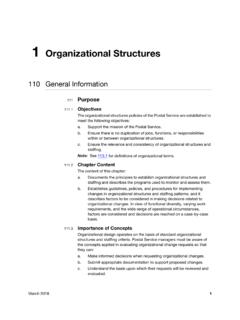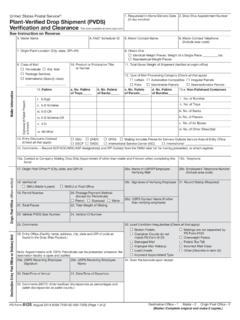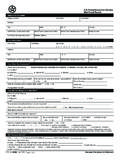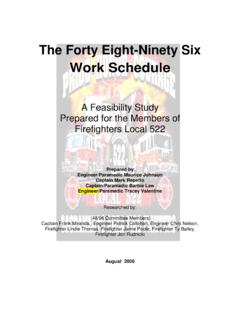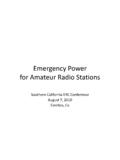Transcription of Stations and Branches - USPS
1 Employees of station S, Brooklyn, New York, Post Office, in 1888. The station , now named Bushwick, still serves Brooklyn residents. Stations and Branches Post Office Stations and Branches are facilities subordinate to a local Post Office that provide a range of postal services. Until 1908, the terms " station " and "branch" were used interchangeably. (See Glossary.) Classified Stations : Post Offices Branch Out by 1837 to Serve Growing Cities The earliest known Post Office branch was established in New York City on January 1, 1837, at the corner of William Street and Exchange Place, to satisfy merchants and banks that complained that the main Post Office had been re-located "too far up-town."1 In 1843 the branch was staffed by about a dozen clerks.
2 By 1845 the William Street branch had closed and another one opened at Chatham Square again, to satisfy citizens inconvenienced by the removal of the main Post Office to yet another location. By order of the Postmaster General, the Chatham Square branch of the New York City Post Office closed on December 31, 1846. Although on March 3, 1847, Congress specifically authorized the Postmaster General to "establish one or more branch post offices .. in any city .. for the convenience of the inhabitants," from 1847 to 1857 only the main Post Office operated in New York In 1853, the New-York Daily Times made the following comparison to illustrate the inadequacy of having only one Post Office in a city of "some six hundred and fifty thousand inhabitants": If the Croton Company were to deliver the water through one pipe only, it would cause the City no little inconvenience, and it seems to us that New-York is placed in a very similar predicament in possessing but one Post-Office.
3 It is absolutely necessary that we should have branch Post-offices distributed over the City, and vitally connected with the General Post-office in The Times considered the numerous "illegal" private posts to be highly unreliable, stating that "a letter once committed to their care is about as certain of reaching its destination as a balloon committed to the four winds of Heaven."4 By mid-1857, the New York Post Office more fully served the city's growing population with six Stations located between 1 to 3 miles from the main Post Office. By the early 1860s, Post Office Stations had opened in other cities as well. Stations Created in Conjunction with City and Rural Free Delivery Stations were established not only to keep pace with cities' population growth but also when formerly independent Post Offices were discontinued and converted to Stations of a larger nearby Post Office.
4 Sometimes this was done to provide free mail delivery to customers, since initially residents of only the most populous cities were eligible for free delivery. On July 1, 1863, when free city delivery began, six Post Offices were discontinued and converted to Stations of the New York Post Office. Around the same time, six Post Offices were consolidated with the Philadelphia Post Office. In the 1870s, more than a dozen Boston-area Post Offices were discontinued and converted to Stations "within delivery of that office." 5 Postmasters of the discontinued Post Offices were given the option of becoming station superintendents. In his 1874 Annual Report, Postmaster General Marshall Jewell noted that Post Offices near Brooklyn and Saint Louis had also been discontinued and converted to Stations .
5 He explained that: Consolidating deliveries into postal centers, and distributing the carriers between the main office and its Branches , shortens the routes and expedites the deliveries and collections, and insures a more harmonious service than could be secured by several independent offices within the same In the 1890s the Post Office Department favored consolidating smaller, suburban Post Offices with larger ones to provide more customers with free delivery, to streamline and modernize management, and to bring more employees into the classified service. Postmasters and other employees of discontinued suburban Post Offices who were absorbed into the ranks of the larger Post Office became eligible for classified Civil Service positions.
6 "Classified" positions were obtained by merit and were safe-guarded from the "spoils" system of political appointments, which was widely recognized as the Achilles' heel of the Department as it led to regular Consolidating Post Offices also helped put a slight dent in the yearly increase in the number of Post Offices. In 1895 there were 70,064 Post Offices and the number was rising every year, creating bureaucratic bottlenecks. All postmasters reported directly to Washington, so that If the Postmaster at a hamlet in the far West desires a ball of twine, he is obliged to make a requisition upon the department at Washington, and the request has to take the course followed by others of vastly greater In July 1894, the delivery area of the Chicago Post Office almost doubled providing service to nearly 97 percent of the city's inhabitants when 59 independent Post Offices "within the confines of Chicago" were consolidated with the Chicago Post Most of the discontinued Post Offices were converted to Stations , often superintended by their former postmasters.
7 The Stations provided identical service to customers but were administratively subordinate to the Chicago Post Office. In January 1896 Postmaster General William Wilson issued "a number of orders" consolidating Post Offices, including 20 Post Offices in Maryland that merged with the Baltimore Post The consolidation of Post Offices was opposed by some members of Congress, who wanted to preserve postmaster (patronage) positions and preserve Post Offices as community centers for rural customers. Congress expressed concern about some Post Office conversions. For example, the Ellicott City, Maryland, Post Office, which was made a station of the Baltimore Post Office in January 1896 even though it was 13 miles from that city, while some offices closer to Baltimore remained To curb the discontinuance of local Post Offices, an Act of Congress of June 9, 1896, prohibited the discontinuance of Post Offices located at county seats and also prohibited the Post Office Department from establishing Stations , substations, or Branches more than five miles beyond the corporate limits of a city.
8 Despite repeated requests by the Postmaster General to lift the five-mile restriction, it remained in place until Rural Stations were established in conjunction with the first county-wide rural free delivery service, which began on December 20, 1899, in Carroll County, Maryland. Sixty-three independent Post Offices, which farmers previously had to visit to get their mail, were discontinued when county residents received free home delivery. Four of the discontinued Post Offices, which served villages of 500 to 700 inhabitants, were converted to Stations of the Westminster Post Office. Initially called "rural free delivery Stations ," by 1902 they were referred to simply as "rural Stations ."13 The 1901 Annual Report of the Postmaster General explained: In county service may be found what are known as rural free-delivery postal Stations .
9 They are established at points where it is desired to provide special money-order and registry facilities for patrons residing in a village or hamlet, and to secure a meeting point for rural carriers for the supply and exchange of mails of routes distant from the main distributing offices. A rural station is invariably established in lieu of a post-office ..14 Naming Stations and Branches Initially, Post Office Stations were designated by letters or local names. Beginning in 1897, Stations were designated as independent if they received and dispatched registered mail directly, bypassing the main Post Office. In May 1908, to help preserve the identity of communities that lost their Post Office, Postmaster General George Meyer ordered that all postal Stations located outside of city limits be called Branches and that they be separately listed in the United States Official Postal Guide.
10 At the same time, the name of the main Post Office was removed from the branch's postmarking stamp, so that, for example, the postmark would read "Cambridge, Mass.," instead of "Boston, Mass., Cambridge station ." Beginning in 1981, postal guidelines specified that the names of new Branches and classified Stations should indicate their locations. For example, in 1987 the station established in the East Bay neighborhood of Provo, Utah, was named East Bay station . On September 20, 1960, the first self-service or "nonpersonnel" rural station was established experimentally at English Lake, Indiana. The station provided individual mailboxes and large boxes for receiving parcels, a stamp vending machine, and a letter drop for outgoing mail, and was briefly staffed by a rural carrier while on his or her route.



